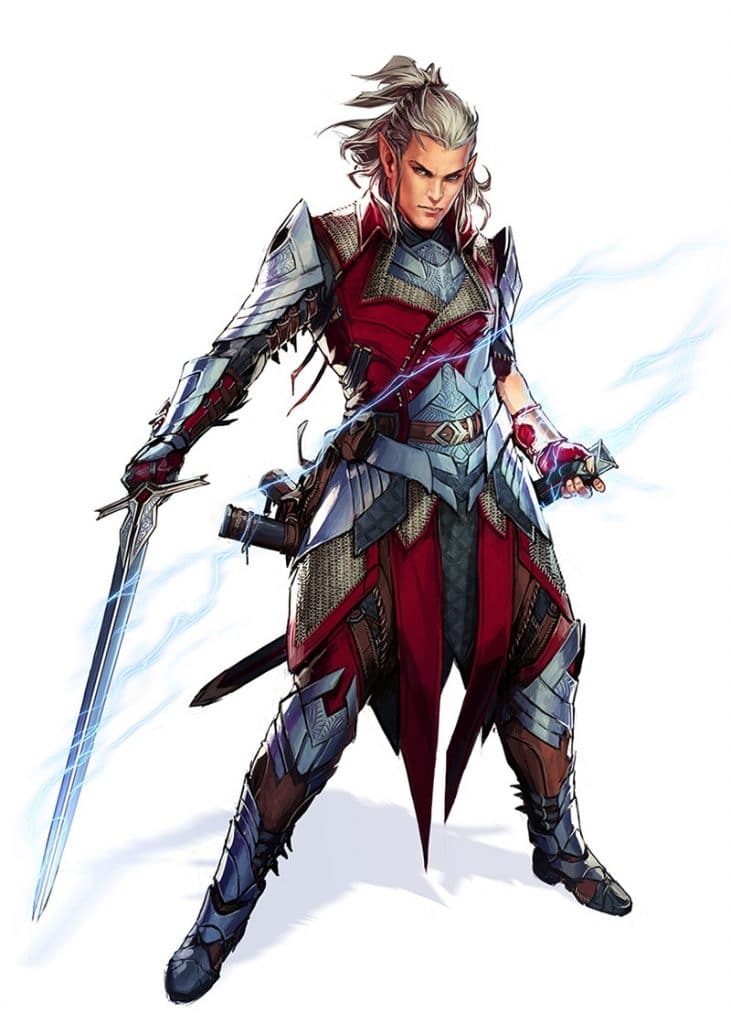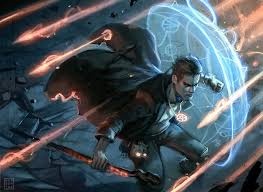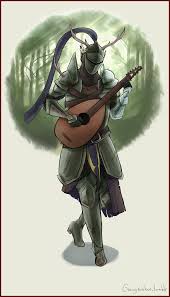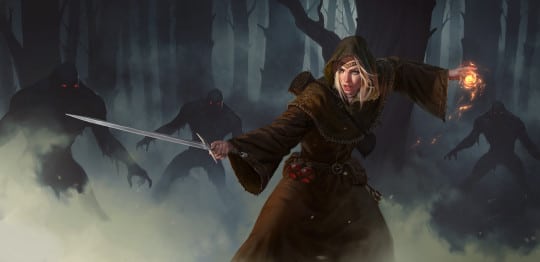Congratulations! You’re a wizard. And with that comes all the spell slinging, arcane enchanting, and tomfoolery that comes with being a wizard. Yet, you have a desire to be up in the front lines protecting. To fight side by side with the barbarian and fighter to show your worth. Then, you stumble across the Sword Coast Adventures Guide and see the Bladesinger. You got curious so you googled “Bladesinger guide”. You then stumbled upon this blog, and now you’re reading this sentence. Well, you are in luck as this Bladesinger guide will go over each detail in the subclass, as well as ways to be optimized, plus suggestions for this class. Without further a due, let us begin.
Color Coding: Meaning
GOLD- “That’s gold Jerry! Gold!” If an ability is highlighted gold, then this means that this ability not only is what defines your subclasses but accomplishes it better than almost any other subclass. I rarely do Gold ratings, so definitely pay attention to them if you see me do it.
Sky Blue –If the ability is sky blue, it means that this ability is a defining trait in your subclass but for one reason or another is not game breaking like gold.
Blue- If it is just blue, then it’s a good ability but there are plenty of other abilities that perform better. Still better to have in a subclass than other colors.
Black. Black is ok. These are your more niche abilities that have bonuses in some situations but not useful in others.
Purple – Purple is for very niche abilities. They have times when they are good, but these are rare and almost never come up. Not the best color to see for an ability.
Red- Red is dead. It is the worse color to see on an ability. That said, no matter the color, an ability can work so don’t ignore a subclass if they have a red. Enough imagination and can-do attitude will make it okay but not optimal.
How Am I Evaluating The Abilities?
So, before we begin the review, we should go over what I am rating and how I get my decision. There are three things that I am looking over in the in-depth review. I look over how strong the subclass is in combat, how much utility it has, and, if applicable, its’ roleplay ability. This way everyone’s playstyle can be shown to fit their needs.
Now, when deciding if something is good for a wizard guide, I look at what the subclass is trying to accomplish. Then look at how successful it succeeds in that task. For instance, the Bladesinger attempts to make you a competitive front line. I then figure out how well that ability succeeds in letting you front line, as well as how soon it comes online. If it is accomplished at level 2 then it is early game. Level 6 it is Early-Mid, Level 10 Late-Mid, and Level 14 is late game. I rate earlier tiers better as most Dungeon and Dragons Campaigns do not go beyond level 8. Without further a due, let start this review on the 5e wizard subclasses.

Wizard Subclass 5e Bladesinger (Early Game)
The Bladesinger is the wizard that makes you a viable front-line. What they sacrifice in hit points, they make up for with a strong AC and magic that can be used at a moment’s notice to buff themselves or debuff the enemy. Their core functions around being an inverse eldritch knight. Meaning they focus on spell casting and attacking on the side, while an eldritch knight focuses on attacking mainly and occasionally casting spells. If you are tired of sitting in the back, then I highly suggest Bladesinger being your subclass.
Bladesinger Guide: Training in War and Song
“When you adopt this tradition at 2nd level, you gain proficiency with light armor, and you gain proficiency with one type of one-handed melee weapon of your choice. You also gain proficiency in the Performance skill if you don’t already have it.”
The immediate notice is gaining proficiency with light armor. Useful, as it means I now do not have to use a spell slot to cast mage armor to protect myself. That said, considering the best nonmagical light armor gives you a 12 AC and Mage armor gives you 13 AC, you are still most likely going to continue to use Mage Armor until you can get magical studded leather armor.
The next benefit is being proficient in a one-handed weapon. Definitely helps you out since you plan on using a weapon to attack every once in a while. My suggestion is rapier as the other weapons that deal 1d8 damage are longswords and the like which use strength. And the biggest thing you need to make sure your optimized is being as little MAD (Multi-attribute dependent) as possible.
Now I am always a fan of free skills. More skills mean more utility. That said, I can count the number of times I needed the performance skill on one hand as a wizard. If you were a bard, then definitely would be more meaningful. So, unless you’re a musical playing front line wizard, I do not see performance being that big. But, hey a free skill is a free skill.
Bladesinger guide: Bladesong
“Starting at 2nd level, you can invoke a secret elven magic called the Bladesong, provided that you aren’t wearing medium or heavy armor or using a shield. It graces you with supernatural speed, agility, and focus. You can use a bonus action to start the Bladesong, which lasts for 1 minute. It ends early if you are incapacitated, if you don medium or heavy armor or a shield, or if you use two hands to make an attack with a weapon. You can also dismiss the Bladesong at any time you choose (no action required).While your Bladesong is active, you gain the following benefits:
– You gain a bonus to your AC equal to your Intelligence modifier (minimum of +1). – Your walking speed increases by 10 feet. – You have advantage on Dexterity (Acrobatics) checks. – You gain a bonus to any Constitution saving throw you make to maintain your concentration on a spell. The bonus equals your Intelligence modifier (minimum of +1). You can use this feature twice. You regain all expended uses of it when you finish a short or long rest.”
Bladesong: Action Economy
Bladesong, the bread and butter of the Bladesinger subclass, and my focus on the Bladesinger guide. The ability comes online at level 2 making this subclass really shine in survivability early on. The first thing to note is it requires a bonus action. This functions much like the rage mechanic meaning that your first turn will almost always use up your bonus action. This said, since you are a Wizard, I would recommend casting a spell to debuff the enemy such as Grease or Tasha’s Hideous Laughter to control the enemy and prep for the next round of combat. The fact that you still have the ability to cast spells to control the field or attack with your sword, allows more combat utility than any other wizard.
Bladesong: Restrictions
So, the first restriction is the racial restriction. To play a bladesinger, you must be of elven descent. This means that if you wish to stay optimal, you will most likely choose Half-elf or High Elf. (Fun points if you play a “high” elf). After all, your two biggest stats are dexterity and intelligence and those two are the only elven races that boost both. Now I find this a little disappointing. Considering your race can play a big role in your personality and backstory. This can pigeon hole many players. After all, if you really want to play a bladesinger, then you should be able to play a bladesinger no matter the race. Maybe just make it recommended.
The second restriction is that you cannot wield a weapon with two hands, nor can you wear medium, heavy armor, or shields. Thankfully there are ways to boost your AC with this class that allows you to not be a complete glass cannon. All in all, restrictions suck. But the biggest restriction is race choice as your race can be a big factor. So, limiting your race does not ruin this class, but it does damper it a little.

Bladesong: AC boost
Now, this is your biggest survivability booster. The only other wizard subclass in 5e that has something like this is the abjuration wizard. Yet, you gain something that in my opinion is better. After all, adventurers kill (literally) for armor that boosts their AC by 1. At level 2 you gain an AC booster that will most likely be a +3. Then by level 8, you gain a +5 to AC. Now, let us work through this. At level 2 you would have mage armor (13) a Dexterity of 16 (+3), Intelligence of 16 (+3), and the spell shield (+5). This would mean at level 2 someone would need to beat a 24AC to hit you.
This also has more variability than just that. For example, Unarmored Defense also stacks with AC. Now, this is much more MAD but still a viable option if you ever wanted to be a wizard monk or wizard barbarian. That said, in the short run you will most likely be worse off as it will take a while to get both of the levels needed for it. But with the right planning, magic items, and work. You can have a 19 intelligence, 20 wisdom, 20 Dexterity. Therefore, at level 20 you would have a 10+5+5+4+5=29 AC. An incredibly high Ac where Tiamat, who has a +19 to hit, has only a 50% chance to hit you. Which in my opinion is insane.
AC boost; what about AOE’s?
Now the biggest fear I hear in other bladesinger guides is “spells like Fireball or Hold Person kill Bladesingers. To which I say “Well these spells usually will not be there at level 2”. That said, this is a serious concern for many who play the blade singer. After all, 24 points of damage will put down a level 4 wizard who has a +1 to Con. A very scary reality to wizards.
In response to those fears, a Fireball will usually hit everyone when cast so even if you stayed in the back you still have to be careful of them. Moreover, a fireball has a save where you take half damage. Reducing that 24 to 12. After that, you will most likely have the spell absorb elements prepared. This cuts it down in half again, converting that 12 to only 6 points of damage. You can then turn that around to harness that energy to deal 1d6 fire damage on your next melee attack. Hence, when people always bring up fireball for squishy wizards, I usually am not worried. Especially considering that that is one way to deal with a fireball. And believe me, there are many.
AC Boost; Regarding Wisdom Saves
Now regarding Hold Person, this is a little bit more worrisome as few things help in countering it. The first point I would address is that a Wizard is proficient in wisdom saves. Meaning, if a wizard has a 10 Wisdom, he would still have a +2 to his save increasing his chances of success by 10%. This would also scale as levels progressed helping against higher DC.
The second point I would address it that you are a wizard. Many people forget about that. At level 5 you would have access to counterspell, or you can cast your own spell to stop the spell caster. Maybe Hold Person just to be funny. This is why I recommend casting a spell first and then do bladesong to ensure a successful battle. All in all, though, dex saves should not be a big concern for you but debuff spells should be what you try to counter.
Bladesong: movement and acrobatics
Ok here is a short one since my last subject was so long. 10 ft is 10 ft and that can make all the difference when needing to fall back or put pressure on the enemy. Especially considering that many spells have a limited range of 30 ft and the only way they are going to work if you get up close. It is even better when you consider it as half of the Feat Mobile. Now that said, why they chose acrobatics as your advantage, I am unsure. Considering you get proficiency in performance. All the same, I won’t complain as that is pretty common especially when needing to escape grapples making this better for your mobility. Everything considered a decent buff but nothing extreme.

Bladesong: Concentration Checks
And I give you my favorite thing about the bladesinger guide. Concentration checks are huge for spellcasters. So much so, that the feat War Caster is deemed a solid choice for any caster for the sole reason they gain advantage on concentrated on checks. This greatly powers up your character in being effective as now even if you are hit by a fireball spell or a basic attack, your spells used to control the battlefield are now much more certain to stay on the battlefield.
I find the best way to describe this, is with the buffing spell Haste. Now Haste does many things, but the big things are adv on dexterity saves, +2 AC, and an extra attack. The big downside is you become lethargic and lose movement and actions your next turn when the spell ends. Now usually you are safe as the spell ends after the battle making the downside null. However, if you are on the front lines and buff yourself if you get hit you need to make a concentration check. Failure to beat the DC results in your spell ending early. This would mean your entire next turn would be to just stand there do nothing and get hit. That is it. It is so deadly that many tank fighters have died as a result of that.
Now, with adding your intelligence score to the roll you round up your defenses to increase your survivability and utility. Making this sky blue in my books.
Bladesinger Guide: Extra Attack
“Starting at 6th level, you can attack twice, instead of once, whenever you take the Attack action on your turn.”
A solid and safe choice. Most gish subclasses that bring casters up front have this. The reason being is because it increases your chance to hit. Increasing your chance to hit is incredibly useful against those with a high AC. For instance, say Tiamat only had one swipe against you. This would mean she has a 50% chance to hit you. However, if she has two attacks then she has a 75% chance to hit. Therefore, why she might miss one of her attacks she increases her odds of at least hitting you once.
“So then why is it only blue?” Another great question! It’s almost like I am the one asking these questions in my bed at 1:00 am. Well, the thought process being, the cantrips Green Flame Blade and Booming Blade. Now, this is a long debate on which one is better which you can read on Reddit. That said, these are both great cantrips, so I recommend you to have both in my bladesinger guide.
The reason being as these are considerably better against those with lower AC. Furthermore, these cantrips use your Intelligence modifier which will most likely be boosted to 20 first. So why you might get two attacks with your rapier, you are using your dexterity which will most likely be lower than your intelligence. However, using these cantrips will net you a higher chance to hit per swing. All in all, it is your choice. But I recommend sticking to cantrips for damage unless they have an incredibly high AC

Bladesinger Guide: Song of Defense
Beginning at 10th level, you can direct your magic to absorb damage while your Bladesong is active. When you take damage, you can use your reaction to expend one spell slot and reduce that damage to you by an amount equal to five times the spell slot’s level.
Hold on, what? Now I have already mentioned how with a high AC and certain spells you can reduce damage taken. Yet here we are with another way to mitigate damage. A great option for later levels considering wizards have 15 spell slots at level 10. Currently, flat damage mitigation is rare. Most are reduced damage by half. So, having an ability that allows you to take zero damage is huge. Especially for low hit point wizards like yourself.
Now there are lots of ways to use this, but it should be noted Bladesong has to be active to cast it and you must have your reaction. This prevents it from being sky blue as many times through a campaign, you will be hit outside of combat. Via falling damage, surprise attacks, or traps usually. This immediately shuts off damage mitigation on those. Moreover, it struggles with using your reaction. As a Wizard, there are numerous reasons to use your reaction. All of which are great in situations and adding this to that list can make it a little bit more cluttered. This said it is still a solid ability that will save your life. So, I rate it pretty good in this bladesinger guide.

Bladesinger Guide: Song of Victory
Starting at 14th level, you add your Intelligence modifier (minimum of +1) to the damage of your melee weapon attacks while your Bladesong is active.
A little late to add this on to the damage. But it’s not like it hurts the class just a little lack luster. If you got this earlier on, I would have rated it higher, However, because you have to be level 14 to get it, I am only giving this an okay rating in my bladesinger guide. Effectively this will add 10 points of damage to your melee attacks a turn IF you hit both times. This is small when you consider at level 14 Green Flame Blade will do 3d8+ Intelligence already, and hit someone else within 5 ft. Nonetheless, more damage is more damage, so it is okay.
Bladesinger Items
Now for many of you, your sold and already have your Bladesinger in mind. Maybe he is dashing maybe he is dark and aloof, but if you’re like me, you want something special to commemorate them.
Maybe it’s a cool figurine or a set of dice. Mine is usually a new set of dice… Like a lot of dice, 37 sets to be exact (And no I do not have a problem). Anyways, if you are looking to help make that new bladesinger special.
Then below I added a few special miniatures that can be bought on amazon, and a list of different items for dice rolling or roleplaying desires depending on how big you want to commit. Check them out as they are great for any bladesinger!
Bladesinger Guide: Review
So, there is my Bladesinger guide that goes in-depth on the review of their abilities. I hope you enjoyed and if you are like me and like looking at numerous guides, might I recommend this one? Or if you know you want to know everything there is about the bladesinger. Buy the Sword Coast Adventurer Guide and become a dedicated bladesinger player. Leave a review in the comments with your thoughts or check my new review of the powerful forge cleric and see which ability even has a gold rating.
- P.S. Now that you know the general information for the bladesinger wizard. Why don’t you kick it up a notch with Wizard’s Mastery: A Complete Wizard’s Guide! Giving you even more information then than this for all ten wizard subclasses with ways to make your gameplay more memorable and more unique. Check it out today!

